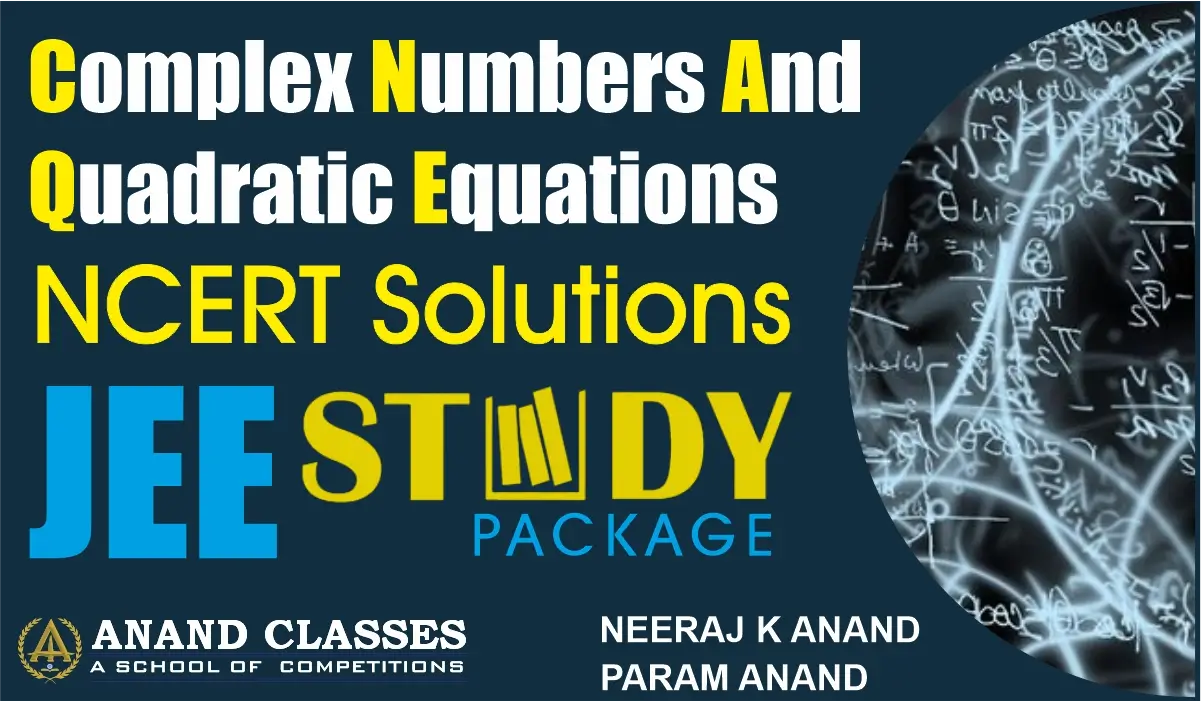NCERT Solutions Class 11 – Chapter 4 Complex Numbers And Quadratic Equations – Miscellaneous Exercise
19 Apr, 2024
var video_api_response = JSON.parse(“[]”);
Question 1. Evaluate left[i^{18}+left(frac{1}{i}right)^{25}right]^3
Solution:
displaystyleleft[i^{18}+left(frac{1}{i}right)^{25}right]^3\ =left[i^{4times4+2}+frac{1}{i^{4times6+1}}right]^3\ =left[(i^4)^{4}.i^2+frac{1}{(i^4)^6.i}right]^3\ =left[i^2+frac{1}{i}right]^3 [i^4=1]\ =left[-1+frac{1}{i}timesfrac{i}{i}right]^3 [i^2=-1]\ =left[-1+frac{i}{i^2}right]^3
= [-1 – i]3
= (-1)3 [1 + i]3
= -[13 + i3 + 3 × 1 × i (1 + i)]
= -[1 + i3 + 3i + 3i2]
= -[1 – i + 3i – 3]
= -[2 + 2i]
= 2 – 2i
Question 2. For any two complex numbers z1 and z2, prove that, Re (z1z2) = Re z1 Re z2 – Im z1 Im z2
Solution:
Let’s assume z1 = x1 + iy1 and z2 = x2 + iy2 as two complex numbers
Product of these complex numbers, z1z2
z1z2 = (x1 + iy1)(x2 + iy2)
= x1(x2 + iy2) + iy1(x2 + iy2)
= x1x2 + ix1y2 + iy1x2 + i2y1y2
= x1x2 + ix1y2 + iy1x2 – y1y2 [i2 = -1]
= (x1x2 – y1y2) + i(x1y2 + y1x2)
Now,
Re(z1z2) = x1x2 – y1y2
⇒ Re(z1z2) = Rez1Rez2 – Imz1Imz2
Hence, proved.
Question 3. Reduce to the standard form displaystyleleft(frac{1}{1-4i}-frac{2}{1+i}right)left(frac{3-4i}{5+i}right)
Solution:
displaystyleleft(frac{1}{1-4i}-frac{2}{1+i}right)left(frac{3-4i}{5+i}right)=left[frac{(1+i)-2(1-4i)}{(1-4i)(1+i)}right]left[frac{3-4i}{5+i}right]\ = left[frac{1+i-2+8i}{1+i-4i-4i^2}right] left[frac{3-4i}{5+i}right]= left[frac{-1+9i}{5-3i}right] left[frac{3-4i}{5+i}right]\ = left[frac{-3+4i+27i-36i^2}{25+5i-15i-3i^2}right]=frac{33+31i}{28-10i}=frac{33+31i}{2(14-5i)}\ = frac{(33+31i)}{2(14-5i)}timesfrac{14+5i}{14+5i}
On multiplying numerator and denominator by (14+5i)
\ =frac{462+165i+434i+155i^2}{2[(14)^2-(5i)^2]}=frac{307+599i}{2(196-25i^2)}\ =frac{307+599i}{2(221)}=frac{307+599i}{442}=frac{307}{442}+frac{599i}{442}
Hence, this is the required standard form.
Question 4. If x – iy = sqrt{frac{a-ib}{c-id}} prove that (x2 + y2)2=frac{a^2+b^2}{c^2+d^2}
Solution:
Given:
x – iy = sqrt{frac{a-ib}{c-id}}
=sqrt{frac{a-ib}{c-id}timesfrac{c+id}{c+id}}
On multiplying numerator and denominator by (c+id)
\ =sqrt{frac{(ac+bd)+i(ad-bc)}{c^2+d^2}}
So,
(x – iy)2 = =frac{(ac+bd)+i(ad-bc)}{c^2+d^2}
x2 – y2 – 2ixy =frac{(ac+bd)+i(ad-bc)}{c^2+d^2}
On comparing real and imaginary parts, we get
x2 – y2 = frac{ac+bd}{c^2+d^2} , -2xy = frac{ad-bc}{c^2+d^2} (1)
(x2 + y2)2 = (x2 – y2)2 + 4x2y2
= left( frac{ac+bd}{c^2+d^2}right)^2+left(frac{ad-bc}{c^2+d^2} right)^2 [Using (1)\ =frac{a^2c^2+b^2d^2+2acbd+a^2d^2+b^2c^2-2adbc}{(c^2+d^2)^2}\ =frac{a^2c^2+b^2d^2+a^2d^2+b^2c^2}{(c^2+d^2)^2}\ = frac{a^2(c^2+d^2)+b^2(c^2+d^2)}{(c^2+d^2)^2}\ =frac{(c^2+d^2)(a^2+b^2)}{(c^2+d^2)^2}\ = frac{a^2+b^2}{c^2+d^2}
Hence proved
Question 5. If z1 = 2 – i, z2 = 1 + i, find left|frac{z_1+z_2+1}{z_1-z_2+1}right|
Solution:
Given, z1 = 2 – i, z2 = 1 + i
left|frac{z_1+z_2+1}{z_1-z_2+1}right|=left|frac{(2-i)+(1+i)+1}{(2-i)-(1+i)+1}right|\ =left|frac{4}{2-2i}right|=left|frac{4}{2(1-i)}right|\ =left|frac{2}{1-i}timesfrac{1+i}{1+i}right|=left|frac{2(1+i)}{1^2-i^2}right|\ =left|frac{2(1+i)}{1+1}right| [i^2=-1]\ =left|frac{2(1+i)}{2}right|\ =|1+i|=sqrt{1^2+1^2}=sqrt2
Hence, the value of left|frac{z_1+z_2+1}{z_1-z_2+1}right| is √2
Question 6. If a + ib = frac{(x+i)^2}{2x^2+1}, prove that a2 + b2 = frac{(x^2+i)^2}{(2x^2+1)^2}
Solution:
Given:
a + ib = frac{(x+i)^2}{2x^2+1}\ =frac{x^2+i^2+2xi}{2x^2+1}\ =frac{x^2-1+i2x}{2x^2+1}\ =frac{x^2-1}{2x^2+1}+ileft(frac{2x}{2x^2+1}right)
On comparing the real and imaginary parts, we have
a = frac{(x-1)}{2x^2+1} and b = frac{2x}{2x^2+1}
Therefore,
a2 + b2 = left(frac{x^2-1}{2x^2+1}right)^2+left(frac{2x}{2x^2+1}right)^2\ =frac{x^4+1-2x^2+4x^2}{(2x+1)^2}\ =frac{x^4+1+2x^2}{(2x^2+1)^2}\ =frac{(x^2+1)^2}{(2x^2+1)^2}
Hence, proved,
a2 + b2 = frac{(x^2+1)^2}{(2x^2+1)^2}
Question 7. Let z1 = 2 – i, z2 = -2 + i. Find
(i) Releft(frac{z_1z_2}{overline{z_1}}right)
(ii) Imleft(frac{1}{z_1overline{z_2}}right)
Solution:
(i) Given:
z1 = 2 – i, z2 = -2 + i
(i) z1z2 = (2 – i)(-2 + i) = -4 + 2i + 2i – i2 = -4 + 4i – (-1) = -3 + 4i
overline{z_1} = 2 + i
Therefore,
frac{z_1z_2}{overline{z_1}}=frac{-3+4i}{2+i}
On multiplying numerator and denominator by (2 – i), we get
frac{z_1z_2}{overline{z_1}}=frac{(-3+4i)(2-i)}{(2+i)(2-i)}=frac{-6+3i+8i-4i^2}{2^2+1^2}=frac{-6+11i-4(-1)}{2^2+1^2}\ =frac{-2+11i}{5}=frac{-2}{5}+frac{11}{5}i
On comparing the real parts, we have
Releft(frac{z_1z_2}{overline{z_1}}right)=frac{-2}{5}
(ii) frac{1}{z_1overline{z_2}}=frac{1}{(2-1)(2+i)}=frac{1}{(2)^2+(1)^2}=frac{1}{5}\
On comparing the imaginary part, we get
Imleft(frac{1}{z_1overline{z_2}}right) = 0
Question 8. Find the real numbers x and y if (x – iy) (3 + 5i) is the conjugate of – 6 – 24i.
Solution:
Let us assume z = (x – iy) (3 + 5i)
z = 3x + xi – 3yi – 5yi2 = 3x + 5xi – 3yi + 5y = (3x + 5y) + i(5x – 3y)
Therefore,
overline{z} =(3x + 5y) – i(5x – 3y)
Also given, overline{z} = -6 – 24i
And,
(3x + 5y) – i(5x – 3y) = -6 -24i
After equating real and imaginary parts, we get
3x + 5y = -6 …… (i)
5x – 3y = 24 …… (ii)
After doing (i) x 3 + (ii) x 5, we have
(9x + 15y) + (25x – 15y) = -18 + 120
34x = 102
x = 102/34 = 3
Putting the value of x in equation (i), we get
3(3) + 5y = -6
5y = -6 – 9 = -15
y = -3
Therefore, the values of x and y are 3 and –3 respectively.
Question 9. Find the modulus of frac{1+i}{1-i}-frac{1-i}{1+i}
Solution:
frac{1+i}{1-i}-frac{1-i}{1+i}=frac{(1+i)^2-(1-i)^2}{(1-i)(1+i)}\ =frac{1+i^2+2i-1-i^2+2i}{1^2+1^2}\ =frac{4i}{2}=2i\ thereforeleft|frac{1+i}{1-i}-frac{1-i}{1+i}right|=|2i|=sqrt{2^2}=2
Question 10. If (x + iy)3 = u + iv, then show that frac{u}{y}+frac{v}{y} = 4(x2 – y2)
Solution:
(x + iy)3 = u + iv
x3 + (iy)3 + 3 × x × iy(x + iy) = u + iv
x3 + i3y3 + 3x2yi + 3xy2 = u + iv
x3 – iy3 + 3x2yi – 3xy2 = u + iv
(x3 – 3xy2) + i(3x2y – y3) = u + iv
On equating real and imaginary parts, we get
u = x3 – 3xy2, v = 3x2y – y3
frac{u}{x}+frac{v}{y}=frac{x^3-3xy^2}{x}+frac{3x^2y-y^3}{y}\ =frac{x(x^2-3y^2)}{x}+frac{y(3x^2y-y)}{y}
= x2 – 3y2 + 3x2 – y2
= 4x2 – 4y2
= 4(x2 – y2)
thereforefrac{u}{x}+frac{v}{y}=4(x^2-y^2)
Hence proved
Question 11. If α and β are different complex numbers with |β| = 1, then find left|frac{beta-alpha}{1-overline{alpha}beta}right|
Solution:
Assume α = a + ib and β = x + iy
Given: |β| = 1
So, sqrt{x^2+y^2}=1
= x2 + y2 = 1 ….(1)
left|frac{beta-alpha}{1-overline{alpha}beta}right|=left|frac{(x+iy)(a+ib)}{1-(a-ib)(x+iy)}right|\ =left|frac{(x-a)+i(y-b)}{1-(ax+aiy-ibx+by)}right|\ =left|frac{(x-a)+i(y-b)}{(1-ax-by)+i(bx-ay)}right|\ =left|frac{(x-a)+i(y-b)}{(1-ax-by)+i(bx-ay)}right| left[left|frac{z_1}{z_2}right|=left|frac{z_1}{z_2}right|right]\ =frac{sqrt{(x-a)^2+(y-b)^2}}{sqrt{(1-ax-by)^2+(bx-ay)^2}}\ =frac{sqrt{x^2+a^2-2ax+y^2+b^2-2by}}{sqrt{1+a^2x^2+b^2y^2-2ax+2abxy-2by+b^2x^2+a^2y^2-2abxy}}\ =frac{sqrt{(x^2+y^2)+a^2+b^2-2ax-2by}}{sqrt{1+a^2(x^2+y^2)+b^2(y^2+x^2)-2ax-2by}}\ =frac{sqrt{1+a^2+b^2-2ax-2by}}{sqrt{1+a^2+b^2-2ax-2by}} [Using (1)]
= 1
thereforeleft|frac{beta-alpha}{1-overline{alpha}beta}right|=1
Question 12. Find the number of non-zero integral solutions of the equation |1 – i|x = 2x
Solution:
|1 – i|x = 2t
(sqrt{1^2+(-1)^2})^x=2^x\ (sqrt2)^x=2^x\ 2^{frac{x}{2}}=2^x\ frac{x}{2}=x
x = 2x
2x – x = 0
Thus, ‘0’ is the only integral solution of the given equation.
Therefore, the number of non-zero integral solutions of the given equation is 0.
Question 13. If (a + ib) (c + id) (e + if) (g + ih) = A + iB, then show that (a2 + b2) (c2 + d2) (e2 + f2) (g2 + h2) = A2 + B2.
Solution:
Given:
(a + ib)(c + id)(e + if)(g + ih) = A + iB
Therefore,
|(a + ib)(c + id)(e + if)(g + ih)| = |A + iB|
= |(a + ib)| × |(c + id)| × |(e + if)| × |(g + ih)| = |A + iB|
sqrt{a^2+b^2}timessqrt{c^2+d^2}timessqrt{e^2+f^2}timessqrt{g^2+h^2}=sqrt{A^2+B^2}
On squaring both sides, we get
(a2 + b2) (c2 + d2) (e2 + f2) (g2 + h2) = A2 + B2
Hence, proved.
Question 14. If, then find the least positive integral value of m. left(frac{1+i}{1-i}right)^m=1
Solution:
left(frac{1+i}{1-i}right)^m=1
left(frac{1+i}{1-i}timesfrac{1+i}{1+i}right)^m=1\ left(frac{(1+i)^2}{1^2+1^2}right)^m=1\ left(frac{1-1+2i}{2}right)^m=1\ left(frac{2i}{2}right)^m=1
im = 1
Hence, m = 4k, where k is some integer.
Hence, the least positive integer is 1.
Thus, the least positive integral value of m is 4 (= 4 × 1).
const rawVideoDataMap = null;
// Convert it into a JS Map
const videoDataMap = new Map(Object.entries(rawVideoDataMap));
document.addEventListener(‘DOMContentLoaded’, function () {
let currentlySelectedTile = document.getElementById(“video-info-container-title”);
let firstVideoH2;
let firstSelectedVideo
var videoPlayer = document.getElementById(‘video-iframe-container’);
if (!videoPlayer) return;
var videoIframe = videoPlayer.querySelector(‘iframe’);
if (!videoIframe) return;
// Safely inject PHP data as JSON into JavaScript
var resp = null;
function postToIframeWhenReady(iframe, data, maxAttempts = 20, intervalTime = 100) {
let attempts = 0;
const interval = setInterval(() => {
if (iframe && iframe.contentWindow) {
try {
iframe.contentWindow.postMessage(data, ‘*’);
clearInterval(interval);
} catch (err) {
console.warn(“❌ Failed to postMessage, retrying…”);
}
}
if (++attempts >= maxAttempts) {
console.warn(“⚠️ postMessage failed: iframe not ready after multiple attempts.”);
clearInterval(interval);
}
}, intervalTime);
}
// Call the function right after iframe is confirmed to exist
videoIframe.onload = function () {
postToIframeWhenReady(videoIframe, { resp: resp, inView: false });
};
const playlistContainer = document.getElementById(“video-playlist-container”);
if(playlistContainer) {
firstSelectedVideo = playlistContainer.querySelectorAll(‘.playlist-video-tile’)[0];
if(firstSelectedVideo) {
firstVideoH2 = firstSelectedVideo.querySelector(‘h2’);
firstVideoH2.style.setProperty(‘color’, ‘var(–discussion-button-color)’, ‘important’);
}
}
function changeCurrentPlayingVideoTitle(tile, autoplayed = true) {
const playlistVideoTileHeading = tile.querySelector(‘h2’);
if (playlistVideoTileHeading) {
if(!autoplayed && firstVideoH2.innerText !== playlistVideoTileHeading.innerText) {
firstVideoH2.style.setProperty(‘color’, ‘#EC4E20’, ‘important’);
}
if(autoplayed) {
let siblingElement = tile.previousElementSibling;
const siblingElementH2 = siblingElement.querySelector(‘h2’);
siblingElementH2.style.setProperty(‘color’, ‘#EC4E20’, ‘important’);
firstVideoH2 = playlistVideoTileHeading;
}
playlistVideoTileHeading.style.setProperty(‘color’, ‘var(–discussion-button-color)’, ‘important’);
if (currentlySelectedTile) {
currentlySelectedTile.innerText = playlistVideoTileHeading.innerText;
}
}
}
// Inject the video data map as a JS object
window.addEventListener(‘message’, function (event) {
if (event.data.type === ‘AUTOPLAYED_NEXT_VIDEO’ && event.data.autoplayPlaylistEnabled) {
// Changing the current video index on autoplaying the next video from playlist
const allVideoTiles = Array.from(document.querySelectorAll(‘.playlist-video-tile’));
changeCurrentPlayingVideoTitle(allVideoTiles[event.data.currentVideoIndex]);
}
});
if(playlistContainer) {
playlistContainer.addEventListener(‘click’, (event) => {
const tile = event.target.closest(‘.playlist-video-tile’);
// Find the index of the clicked tile
const allTiles = Array.from(playlistContainer.querySelectorAll(‘.playlist-video-tile’));
const currentIndex = allTiles.findIndex((el) => el === tile);
if (tile) {
const videoId = tile.getAttribute(‘data-video-id’);
const videoData = videoDataMap.get(videoId);
videoIframe.contentWindow.postMessage({ playlist: [videoData], inView: true, clickedVideoFromPlaylist: true, currentIndex: currentIndex }, ‘*’);
// handleVideoTitle([videoData]);
changeCurrentPlayingVideoTitle(tile, false);
firstVideoH2 = tile.querySelector(‘h2’);
}
});
}
});
var video_api_response = JSON.parse(“[]”);
Explore
Maths
4 min read
Basic Arithmetic
What are Numbers?
15+ min read
Arithmetic Operations
9 min read
Fractions – Definition, Types and Examples
7 min read
What are Decimals?
10 min read
Exponents
9 min read
Percentage
4 min read
Algebra
Variable in Maths
5 min read
Polynomials| Degree | Types | Properties and Examples
9 min read
Coefficient
8 min read
Algebraic Identities
14 min read
Properties of Algebraic Operations
3 min read
Geometry
Lines and Angles
9 min read
Geometric Shapes in Maths
2 min read
Area and Perimeter of Shapes | Formula and Examples
10 min read
Surface Areas and Volumes
10 min read
Points, Lines and Planes
14 min read
Coordinate Axes and Coordinate Planes in 3D space
6 min read
Trigonometry & Vector Algebra
Trigonometric Ratios
4 min read
Trigonometric Equations | Definition, Examples & How to Solve
9 min read
Trigonometric Identities
7 min read
Trigonometric Functions
6 min read
Inverse Trigonometric Functions | Definition, Formula, Types and Examples
11 min read
Inverse Trigonometric Identities
9 min read
Calculus
Introduction to Differential Calculus
6 min read
Limits in Calculus
12 min read
Continuity of Functions
10 min read
Differentiation
2 min read
Differentiability of Functions
9 min read
Integration
3 min read
Probability and Statistics
Basic Concepts of Probability
7 min read
Bayes’ Theorem
13 min read
Probability Distribution – Function, Formula, Table
13 min read
Descriptive Statistic
5 min read
What is Inferential Statistics?
7 min read
Measures of Central Tendency in Statistics
11 min read
Set Theory
3 min read



